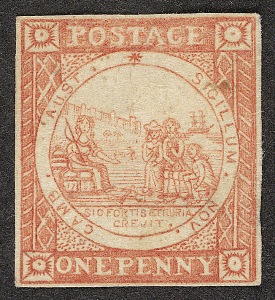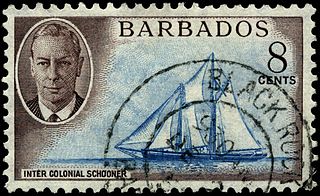


St. Lucia a former British dependency in the Windward Islands began using stamps in 1860. It achieved Associated Statehood on 1 March 1967. [1] [2] In 1979, it gained independence.



St. Lucia a former British dependency in the Windward Islands began using stamps in 1860. It achieved Associated Statehood on 1 March 1967. [1] [2] In 1979, it gained independence.
Letters to the United Kingdom from St. Lucia had to be prepaid from 1 April 1858. British stamps were authorised for use in St Lucia and this information was conveyed to the Colonial Postmaster by Rowland Hill. Supplies for 2 months consumption (£50) were sent out on about 16 April 1858 consisting of 1d, 4d & 6d stamps along with an obliterating tool marked "A11".
Further supplies of stamps may have been sent out later, but no records exist of the numbers involved, they may have included 2d and 1s values. [3] The numbers are likely to have been small as at this time it is probable that only about 200 people on the island could read or write.[ citation needed ]
Obliterators were sent to the island from Great Britain with the designator "A11" to coincide with the dispatch of British Stamps to the colony (see above). The first was sent on 16 April 1858 with the first recorded use on 28 August that year. [4]
The first stamps issued by St. Lucia were put on sale in 1860 and consisted of three duties (1d, 4d and 6d). The stamps were printed by Perkins Bacon Ltd using the line-engraved process. [5] To save the colony money, only one plate was engraved, with the duties identified by the colour of the stamps, red for 1d, blue for 4d and green for 6d.
The die for the first stamps was finished on 16 October 1860 and used the Queen Victoria head engraved for them in May by C. H. Jeens for use on the 9d duty of South Australia. Jeens was paid £2 12s 6d for the drawing and £9 9s for the engraving. A vertical oval big enough for the head was cleared in the engraved background. This was surrounded by a plain band with "ST. LUCIA" and "POSTAGE". The design is considered to be one of Perkins Bacon's most elegant.
Thirty six sheets were printed in red (8640 stamps), 13 sheets in blue (3120 stamps) and 17 sheets in green (4080 stamps). These sheets were dispatched to the island by packet on 17 November 1860. [6] The stamps were printed on paper produced by Rush Mills at Northampton and under the control of Stacey Wise. The paper was watermarked by a small six pointed star as well as around the margin with "POSTAGE" twice at the sides and once at the top and bottom, the spaces between being filled by five parallel lines.
The stamps were printed by a Mr. Dix on 10 November, and perforated by a Miss Stewart on 14 November. The perforation needles were set to 14 to 16 and often became clogged giving rough perforations.
The first issue of these stamps was made on 18 December 1860 and details were printed in the Island Gazette for the 19th with stamps in red for sale at a price of one penny, blue at four pence and green at six pence.

This company carried mail by sea from Castries to the coastal villages of St. Lucia. Stamps were issued from around 1871 to 1872 when the company went out of business. A possibly provisional stamp is illustrated in the book by Hurt and Williams which was followed by the issue of several values depicting a steamship in an oval frame. There are a number of different printings of the stamps which may be distinguished by paper and gum variations. [7]

The postal and philatelic history of Canada concerns postage of the territories which have formed Canada. Before Canadian confederation, the colonies of British Columbia and Vancouver Island, Prince Edward Island, Nova Scotia, New Brunswick and Newfoundland issued stamps in their own names. The postal history falls into four major periods: French control (1604–1763), British control (1763–1841), colonial government control (1841–1867), and Canada, since 1867.

The Penny Red was a British postage stamp, issued in 1841. It succeeded the Penny Black and continued as the main type of postage stamp in the United Kingdom of Great Britain and Ireland until 1879, with only minor changes to the design during that time. The colour was changed from black to red because of difficulty in seeing a cancellation mark on the Penny Black; a black cancellation mark was readily visible on a Penny Red.

Postage stamps and postal history of Great Britain surveys postal history from the United Kingdom and the postage stamps issued by that country and its various historical territories until the present day.

This is a survey of the postage stamps and postal history of the Falkland Islands.

The Inverted Swan, a 4-pence blue postage stamp issued in 1855 by Western Australia, was one of the world's first invert errors. Technically, it is the frame that is inverted, not the image of the swan, but it has become commonly known as the Inverted Swan.

This is a survey of the postage stamps and postal history of New South Wales, a former British colony now part of Australia.

The postal history of the Bahamas begins in the 18th century, with the first post office operating since 1733. The earliest known letters date from 1802. In 1804 a straight-line "BAHAMAS" handstamp came into use. The Royal Mail Line initiated a regular mail service in 1841, and from 1846 used a "Crown Paid" handstamp along with a dated postmark for New Providence.

The postal history of Malta began in the early modern period, when pre-adhesive mail was delivered to foreign destinations by privately owned ships for a fee. The earliest known letter from Malta, sent during the rule of the Order of St John, is dated 1532. The first formal postal service on the islands was established by the Order in 1708, with the post office being located at the Casa del Commun Tesoro in Valletta. The first postal markings on mail appeared later on in the 18th century.

The Chalon Head is the name of a number of postage stamp series whose illustration was inspired by a portrait of Queen Victoria by Alfred Edward Chalon (1780–1860).

Mauritius, a small island in the southwest Indian Ocean, is important to the world of philately for a number of reasons. Its first two postage stamps issued in 1847, called the "Post Office" stamps, are of legendary rarity and value. They were the first stamps issued in any part of the British Empire outside of Great Britain. The unique cover bearing both “Post Office” stamps has been called "la pièce de résistance de toute la philatélie" or "the greatest item in all philately". The cover was sold at auction, in Zurich, on 3 November 1993, for 5.75 million Swiss francs, the equivalent of about $4 million – the highest price ever paid for a single philatelic item up to that time. In addition, Mauritius is well known for the subsequent locally produced issues known as "primitives," also prized by collectors.
Antigua was discovered by Christopher Columbus, in 1493, and was named after the church of Santa Maria la Antigua in Seville. It was first settled in 1632. By the Treaty of Breda in 1667 it became a British Possession.

This is a survey of the postage stamps and postal history of Barbados.
Belize started as the colony of British Honduras, formally established in the 17th century but disputed through the 18th century.

This is a survey of the postage stamps and postal history of Cape of Good Hope.

Western Australia, a state of Australia and formerly a British colony, established its postal service soon after the British settled in 1829; in December of that year, Fremantle's harbourmaster was appointed postmaster. A post office in Albany opened on 14 October 1834, and the main post office moved to Perth in 1835.

The British Library Philatelic Collections is the national philatelic collection of the United Kingdom with over 8 million items from around the world. It was established in 1891 as part of the British Museum Library, later to become the British Library, with the collection of Thomas Tapling. In addition to bequests and continuing donations, the library received consistent deposits by the Crown Agency and has become a primary research collection for British Empire and international history. The collections contain a wide range of artefacts in addition to postage stamps, from newspaper stamps to a press used to print the first British postage stamps.
This is a survey of the postage stamps and postal history of Grenada.

This is a survey of the postage stamps and postal history of South Australia, a former British colony that is now part of Australia.

The Melita issue is a series of dual-purpose postage and revenue stamps issued by the Crown Colony of Malta between 1922 and 1926, depicting the national personification Melita. They were commemorative stamps since they celebrated the islands' new status as a self-governing colony following a new constitution in 1921, but also a definitive issue intended for regular use over an extended period of time.

The Black Swan is the first postage stamp issued by the British colony of Western Australia in 1854. It illustrates a black swan, a typical Australian animal at the time and was the only image used on Western Australian stamps until 1902.